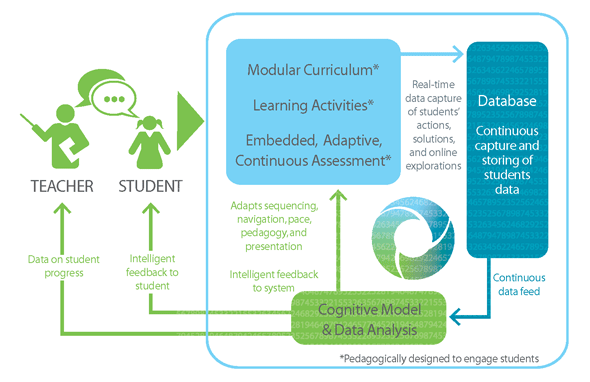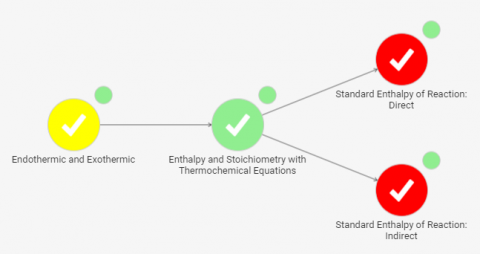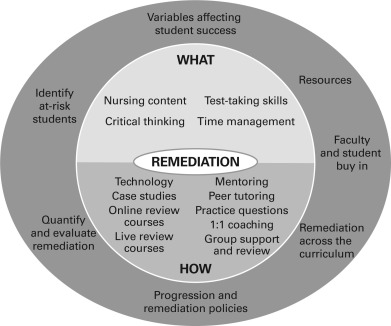Traditional learning and instruction are linear in nature, as the entire course is spanned over some lessons that are covered in a linear manner. This linear teaching is followed by a linear testing or evaluation process.
Adaptive learning, on the other hand, offers the educators and learners more flexibility and adds a touch of personalization to the overall experience. The testing and evaluation are also non-linear in nature.
Let us understand both these techniques with the help of an example.
Susan and Kyle both teach Maths to Grade 7. While Susan has a traditional teaching approach, Kyle opts for adaptive teaching.
Susan covered all the chapters one by one, conducting unit-end assessments and semester-end assessments for student evaluation. Kyle, on the other hand, taught one chapter and then tested the students. He found that only 10 out of 15 students were able to solve the questions in the test.
He then gave a special lesson to the students who were underperforming and covered the same concepts differently because he knew that the original way of instruction failed to bring results for these students.
He organized another test for the class, and this time, all the students passed the exam.
While the first approach is traditional and mostly fails to identify any hidden trends (inability to understand the topic in one go among some students), the second approach ensured that all the students were able to understand the topic.
Also, the second approach made sure that teaching and learning was a mutually fulfilling experience for both – Kyle and his students.
Hence, adaptive learning is a better, more personalized, and more rewarding learning approach that works perfectly well at all levels of education – from schools to colleges and beyond!
Here, we discuss the various benefits of adaptive learning, emerging trends in the industry, and how it differs from personalized learning.
Let us begin by exploring the term itself.
What Is Adaptive Learning and Why Is It Beneficial?
Gartner defines adaptive learning as a learning methodology that changes the pedagogical teaching approach based on the inputs from the student and a predefined response. It is also associated with gathering a large-scale collection of statistically based pedagogical responses and learning data. While it is often confused with personalized learning, it is a subset of personalized learning and includes various technical processes.
Take a look at the following image that offers an overview of adaptive learning:
What makes adaptive learning so important is the fact that it finds application in all types and all levels of learning and training. Be it employee training or corporate learning, or teaching in the K-12 cadre, adaptive learning is effective in each stage of learning.
Take a look at the following image that shows how adaptive learning is beneficial for various education stakeholders, namely – teachers, students, and educational institutions:
Apart from reducing the gaps in understanding for the learners, the adaptive learning methodology allows the teachers to monitor individual progress as well. The teachers can also devote personal attention to every student, find their weaknesses, and help the students in overcoming them.
As the students are able to get more value from education, the educational institutions can enable personalized learning on a large scale and enjoy a greater level of academic success.
At the corporate level, the benefits of adaptive learning are shown in the following image:
As the employees are able to identify their skill and learning gaps, they can opt for focused remediation, and the companies can also create individualized learning paths for all the employees.
Some other ways adaptive learning is beneficial are as follows:
- It clarifies the learning as well as teaching priorities
- It is a flexible learning approach
- It makes learning a curated and personalized experience
- It allows the education stakeholders to see the existing gaps in each individual on both sides, teaching, and learning
- It is way better than the traditional “one-size-fits-all” training approach
- A more efficient way of teaching and boosts engagement
Next, we explore the various trends and use cases in adaptive learning.
Trends and Use Cases in Adaptive Learning
The global adaptive learning industry is projected to grow with a CAGR of 22.7% and hit the 5.32 bn USD mark by 2025. The increasing demand for eLearning solutions, government initiatives, and personalized learning are some of the major drivers of the industry’s growth.
While the services segment is expected to grow at a higher CAGR during the time, the academics are expected to hold a higher market share during the forecast period.
A recent feature in Forbes pointed out how adaptive learning is breaking down the barriers in education and reshaping the classroom.
Next, we discuss some major use cases of adaptive learning in the education industry.
1. Need to Engage and Instruct in Different Ways
Over the years, the education industry is seeking a wave of change in relation to student engagement and personalized instruction.
Using the data gathered from students in the classroom, the educators can identify numerous things, such as:
- Performance analysis
- Engagement statistics
- Readiness to learn
- Weaknesses and Strengths
- The preferred or best mode of learning
Best way to improve the overall student learning experience
What makes these insights even better is the fact that all of them stem from data and are highly reliable.
2. Portable Education
As more and more educational resources are available online and the educational institutions are offering all the curriculum material online, education has become portable. The students can take lessons from anywhere and sometimes at any time of the day (remote learning).
Further, as the pandemic continues to rage, a majority of educational institutions are opting for online education, and taking classes and tests in the online mode has become the new normal.
Hence, adaptive learning will become an extremely important asset for the education stakeholders as they will need new means to gauge student performance, motivation, engagement, and overall learning experience in a more reliable way.
3. Immediate Feedback
As the teachers have all the required student data at hand, and robust technological resources to process the same, they can offer immediate feedback. Also, they can keep this feedback as detailed and insightful as possible.
Hence, the students can actually know where they are lacking.
Let us take an example to understand how this immediate and exact feedback can contribute to better learning.
Mandy and Issac are Grade 11 students and have recently taken their Chemistry exam. Both of them have secured 88 marks out of 100.
At first glance, one might think that both of them are at par with each other as both of them have obtained the same marks. This is the approach of traditional learning.
However, their Chemistry teacher also shared detailed student feedback, which was as follows for both the students.
Mandy:
Organic Chemistry: 22 out of 30
Inorganic Chemistry: 38 out of 40
Physical: 28 out of 30
Issac:
Organic Chemistry: 18 out of 30
Inorganic Chemistry: 32 out of 40
Physical: 30 out of 30
Now, both the students vary greatly in terms of their understanding of the various concepts.
While this is just a cursory example of how detailed feedback can help the teachers and students, adaptive learning offers more granular feedback, such as:
- Problem-solving skills
- Understanding of concepts
- Analytical skills
- Fact recapitulation, etc.
4. Reinforcing the Right Factors
Now, as the teachers know the exact weaknesses, strengths, and learning-related aspects of every student, they can reinforce the right factors to make learning more effective and fulfilling for each student.
They can design the teaching modules, evaluation methodologies, and overall teaching strategy keeping all these things in mind. This way, all the students can make the most of their time and efforts in earning the education.
Now that we have explored the various upcoming trends and use cases of adaptive learning, let us move on to explore some key benefits of adaptive learning in academics.
Benefits of Adaptive Learning
1. Individualized Learning
Traditional and standard teaching techniques often lead the educators to keep the instruction at the level of “middle performers or the average students”. They move at a pace that suits an average student, which is a problem for both – the underperformers and the overachievers.
The low-performing students are often not given proper attention in the class and end up with little knowledge, which we all know, is a dangerous thing (Just for laughs).
The overachievers, on the other hand, tend to find these average lectures less engaging and end up losing interest in the classes and opt for other sources of teaching, such as tuitions and extra classes from advanced tutors.
Adaptive learning, however, allows each student to progress at their own rate via the regular coursework. The smart students can show their command over the fundamental concepts and can move on to more lofty areas. Likewise, the students with poor understanding, and in the need of more practice and reiterations, can go through the lessons as many times as they need.
Hence, the teacher is now catering to the learning needs of all the students individually, instead of teaching the entire class with average skills.
2. Better Time Efficiency
As the students are interacting with a wide range of educational content, activities, and are taking varied assessments, they are spending time in remediation, instead of cramming. The students no longer have to memorize the same questions for tests and are working on their overall grasp and understanding of the concepts and their application.
This allows the teachers and students to manage the time efficiently as they can:
- Get instant feedback
- Practice on remediation of their weaknesses
- Acquire skills and knowledge that matters
- Maximize their gains from education
3. Personalized Learning Paths
Adaptive learning tools will offer a visual representation of the learning progress of every student, and that visual progress is transparent. So, at a moment, both the teachers and the students are able to see whether the student is now ready to move on to the next topic or more advanced questions or not.
For example, take a look at the following image that shows the various topics in the Thermodynamics unit:
With clear-cut milestones and individual student performance available in the adaptive learning software interface, the teacher can easily determine which students are ready for which milestone and which ones need more practice.
Hence, the learning becomes extremely personalized and fulfilling for every student in the class, which is the ultimate aim of every educator!
4. Confidence-Based Learning Approach
Confidence-based learning techniques assess the students on the basis of the correctness of their knowledge and identify “how confident they feel about their answers“. Hence, apart from marking the answers in an exam, they also mark how confident they are about the correctness of their responses.
So, the teachers are able to get exact data on where the students might be getting marks for guessing and not “actually solving” a question.
Now, the confidence and performance are inter-related, and the Four Knowledge Quadrants of Dr. James E. Bruno is the best representation of the same:
As you can see, the misinformed students are the most likely to make mistakes, despite being confident and the uninformed students enter into a state of mental paralysis while marking the answers. The students having some doubts will experience hesitation while answering any question in the exam. They are not clear about their understanding of the various topics and will only hesitate while finalizing their answer choice in the exam. Only the students that have mastery in a subject or topic will be able to take smart actions in an exam with proper confidence. This is because they understand every topic fully, down to the granular level.
Adaptive learning opts for a confidence-based learning approach that improves the mastery of each student at their own pace and takes them towards better understanding and performance.
5. Facilitates Focused Remediation
By now, you might be quite clear about how adaptive learning facilitates focused remediation. As the teacher knows how many students have achieved mastery over a certain topic and which ones are still not able to solve the advanced questions, they can remediate the situations properly.
For example, the following image shows focused remediation for nursing students:
So, the hurdles faced by every student are taken care of one by one and the teachers can facilitate better learning for each one of their students.
Take a look at the visual representation of how a “master learner” thinks and learns:
6. Personalized Learning for a Highly Diverse Group of Learners
Now, you might think how this benefit is any different from the previous personalization benefit discussed above?
Then, take a quick look at the following example.
Jack was teaching a class of 8 students and was motivated to impart adaptive learning. He prepared different course modules and did thorough research of the student exams and answers to gain insights into each one of them.
While the job seemed easier at first, the more he penetrated into the student data, the more he realized that things are getting complex. So, he stopped diving further into the individual assessment and helped them with whatever methods he could.
The results were obvious and all the students exhibited better learning and results.
Based on Jack's efforts, lots of parents enrolled their kids in his classes. Next year, his class had 28 students and now, he was clueless about how to ensure personalized learning for such a diverse group of learners.
Adaptive learning tech empowers educators with stunning unbeatable power of computing, data, and analytics to deliver highly personalized learning on a large scale. So, the teachers don’t have to spend time on manual analysis and module creation.
They can get insights from the student data and compile modules and assessments with the help of technology.
Hence, it is highly relevant and beneficial for academics.
How to Implement Adaptive Learning Technology?
There’s no denying the numerous benefits of adaptive learning programs. These can bring the much-needed change to traditional educational institutions and empower teachers to provide personalized learning experiences to students. However, before implementing adaptive learning technologies, the institution should know what to do, how it handles the process, and what aspects to consider to make the entire experience smooth and stress-free for everyone involved.
Here’s how educators and school management can implement learning technologies effectively.
Assess the Situation
Start by having a clear idea about the existing situation in the establishment. Conduct a readiness assessment to determine if the teachers, students, parents, and other stakeholders are ready for new developments. Can the institution support new technology? Do you have the budget for it? On what scale will you implement the technology? How will it affect the involved parties? What changes will you have to make? Will you partner with an EdTech service provider? Answer these questions in detail to determine the next step.
Communicate with Teachers and Parents
Once the management has a good grasp of the situation, the next step is to discuss the issue with important parties – the teachers and parents. After all, teachers will have to use the new technology in the classrooms, and parents should know how these changes will affect their children’s learning experiences. Instead of implementing the changes first and informing later, involve them from the beginning. This allows the stakeholders to get used to the idea of adaptive learning and AI technologies as a part of their daily activities. It also enables them to share their concerns, fears, and opinions.
Build a Team for Collaboration
The next step is to build a team with teachers, administrators, and tech experts to supervise the process of implementing adaptive technologies in the institution. Even if you hire a third-party service provider, create an in-house team to collaborate with the outside experts. They can discuss the minute details and ensure the customization and implementation processes are seamless. This also reduces the risk of miscommunication.
Provide Training for Teachers
Another name for adaptive learning is adaptive teaching. Teachers should have the required technological knowledge to effectively use the new tools and software in the classrooms. For this, provide tech training sessions to teachers even before the new systems are implemented. That way, by the time the adaptive learning technology is ready to be used in the school, teachers will have the required know-how to use it. Training also empowers teachers and helps them refine their skills. They will be less worried about the changes if the establishment makes proactive decisions to support teachers in the process.
Create a Safe Learning Environment
Educational institutions should be safe places for students and teachers. It’s where a person goes hoping to gain new knowledge and skills. Hence, when implementing adaptive technologies, make sure everyone feels safe and assured that they can make mistakes and become better by improving themselves. This responsibility lies with the school management. Provide students with tutorials or sessions with professionals on how the new technology can help them personalize learning. Remember that trial and error is a part of adopting new technologies.
Use Feedback and Input from Teachers
Conduct trial runs before fully implementing the adaptive technologies throughout the institution. Then, ask for feedback from teachers to know if the systems are aligned with the school’s mission and objectives. Use their input to make adjustments and enhance the new systems. This fine-tuning process can remove glitches and help everyone embrace the technology without worry or stress. Pay attention to the details. These can have a long-lasting impact on students and the school.
Choose High-Quality Technology
When investing in adaptive learning technology, don’t settle for bare minimum or basic solutions. It is better to invest in high-quality technology that gives long-lasting results rather than opt for a cheaper solution that may have to be replaced often. Discuss the adaptivity factors and features with the service providers and tech experts. Will it be helpful to build the system on the cloud? Which LMS is the best choice for your requirements? Which assessment tool should you choose? Do the vendors believe in the ethical use of AI? Do they guarantee data security and compliance?
Alignment with Curriculum
The whole purpose of adaptive learning is to help students understand the subjects better and have a better learning experience. This will not happen if the solutions implemented are not aligned with the curriculum. The content created for adaptive learning technologies should be in sync with the curriculum and leveled for different proficiencies. It should also be built on reliable educational frameworks and models to give the desired results.
Take Student Feedback
After you implement adaptive learning technologies, make sure to get feedback from students about how they feel and what they like/ dislike. Are the students comfortable with the new software? Do they find it useful in personalizing learning? How can educational institutions enhance their experience? What changes can be incorporated to make the classes more inclusive and student-centric? Remember that it’s a continuous process of using feedback to improve the systems and deliver better experiences.
Hire Support Service Providers
The new systems and technologies will require periodic maintenance and upgrades to run smoothly, without errors or breakdowns. Though you can have an in-house IT team for this, it will be cost-effective to partner with an EdTech service provider. The experts will offer priority troubleshooting and other support services 24*7. They will update the systems, scale the tools, and increase their usability in the long run.
Adaptive Learning: The Future of Education, at All Levels
Adaptive learning in EdTech is a trend that is here to stay and is going to have many far-reaching impacts on how we know education today. Apart from making education more available, it is certainly going to make the experience of teaching and learning at levels, highly rewarding, engaging, and fruitful.
It will help teachers to prepare students keeping the emerging trends in employment in mind and the students will be able to prepare for the high-level entrance exams with the right mindset.
Apart from making the students understand the concepts in a better manner, adaptive learning allows them to change their perspective towards learning and problem-solving. They learn to identify the right way to study, no matter which class or level of education they are in.
Using smart EdTech platforms such as PrepAI will further improve the overall learning experience, as it will test the students on the basis of their actual understanding of the topic, instead of pure cramming.
Finally, adaptive learning is for one and all.
Be it academics, service industry, and employee training, it ensures better learning, better understanding, and better results.
Hence, adaptive learning is also one of the most notable and bankable trends to watch out for in this ongoing wave of the Fourth Industrial Revolution.
FAQs
1. What are the different levels of adaptive learning?
Adaptive learning can happen at different levels, depending on where, why, and how the technology is implemented. The levels are as follows:
- Self-paced interactive level where the student receives immediate feedback after attempting the online tests
- Assessment level where the difficulty of the questions depends on whether the answer submitted is right or wrong
- Content level where the students get explanations for wrong answers, so that they can learn from the mistakes
- Assessment and content level, where the student is given a tailored lesson plan based on their performance in the assessments
There can be variations of the assessment and content level based on the learner’s abilities.
2. What is the role of assessment tools when using adaptive learning technology?
Assessment tools are vital in AI adaptive learning as they help students and teachers understand where things stand and how to improve the learning experience. For example, PrepAI can be used to conduct diverse assessments and discuss personalized feedback with each student to help them structure their learning methods.
3. Is an LMS required to implement adaptive learning?
Adaptive learning can be implemented without LMS, but it results may not be as expected. LMS (learning management systems) and assessment tools like PrepAI are crucial parts of adaptive learning as they create a robust setup for teachers to streamline the process and students to get a tailored learning experience.
4. What are some examples of adaptive learning technologies?
A few examples of adaptive learning technologies are as follows:
- Artificial intelligence and machine learning
- Augmented reality and virtual reality
- Gamification
- Visual media like videos
- Generative AI for lessons and assessments, etc.
Typically, adaptive learning technologies are powerful and built using AI, ML, NLP (natural language processing), etc.
5. What adaptivity factors should I consider when choosing an AI system?
It’s important to choose the right AI system to implement adaptive learning programs in an institution. Consider factors like data quality, scalability, flexibility, compliance, ethical use of AI, data security, ease of use, monitoring and tracking process, online learning options, feedback loops, collaboration, algorithmic selection, and third-party integrations.

 Test Conducting feature is now live. You can now conduct tests from your generated question papers.
Test Conducting feature is now live. You can now conduct tests from your generated question papers.









